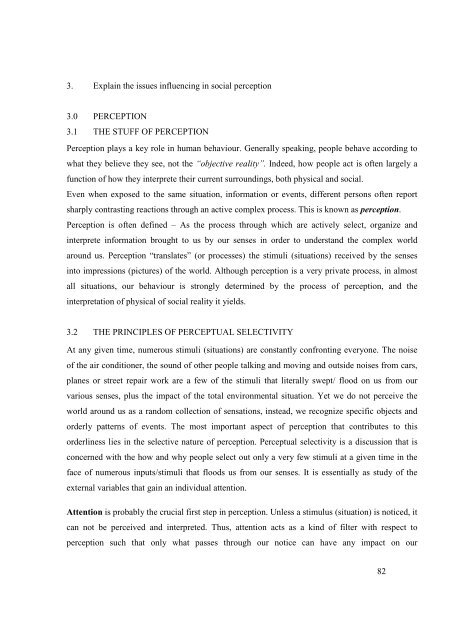HCM 433 MANGEMENT AND ORGANIZATIONAL BEHAVIOUR.pdf
HCM 433 MANGEMENT AND ORGANIZATIONAL BEHAVIOUR.pdf
HCM 433 MANGEMENT AND ORGANIZATIONAL BEHAVIOUR.pdf
You also want an ePaper? Increase the reach of your titles
YUMPU automatically turns print PDFs into web optimized ePapers that Google loves.
3. Explain the issues influencing in social perception<br />
3.0 PERCEPTION<br />
3.1 THE STUFF OF PERCEPTION<br />
Perception plays a key role in human behaviour. Generally speaking, people behave according to<br />
what they believe they see, not the “objective reality”. Indeed, how people act is often largely a<br />
function of how they interprete their current surroundings, both physical and social.<br />
Even when exposed to the same situation, information or events, different persons often report<br />
sharply contrasting reactions through an active complex process. This is known as perception.<br />
Perception is often defined – As the process through which are actively select, organize and<br />
interprete information brought to us by our senses in order to understand the complex world<br />
around us. Perception “translates” (or processes) the stimuli (situations) received by the senses<br />
into impressions (pictures) of the world. Although perception is a very private process, in almost<br />
all situations, our behaviour is strongly determined by the process of perception, and the<br />
interpretation of physical of social reality it yields.<br />
3.2 THE PRINCIPLES OF PERCEPTUAL SELECTIVITY<br />
At any given time, numerous stimuli (situations) are constantly confronting everyone. The noise<br />
of the air conditioner, the sound of other people talking and moving and outside noises from cars,<br />
planes or street repair work are a few of the stimuli that literally swept/ flood on us from our<br />
various senses, plus the impact of the total environmental situation. Yet we do not perceive the<br />
world around us as a random collection of sensations, instead, we recognize specific objects and<br />
orderly patterns of events. The most important aspect of perception that contributes to this<br />
orderliness lies in the selective nature of perception. Perceptual selectivity is a discussion that is<br />
concerned with the how and why people select out only a very few stimuli at a given time in the<br />
face of numerous inputs/stimuli that floods us from our senses. It is essentially as study of the<br />
external variables that gain an individual attention.<br />
Attention is probably the crucial first step in perception. Unless a stimulus (situation) is noticed, it<br />
can not be perceived and interpreted. Thus, attention acts as a kind of filter with respect to<br />
perception such that only what passes through our notice can have any impact on our<br />
82
















